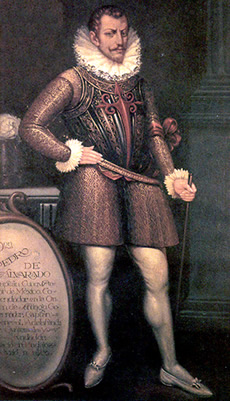 |
| Pedro de Alvarado - Spanish Conquistador |
His flowing blond hair, imposing demeanor, and skill in battle reportedly prompted the Aztecs to nicknamed him Tonatiuh, meaning “the daytime Sun” (an exceptionally high compliment in their solar-centric culture), while the Indians of Guatemala are said to have considered him so handsome and cruel that they made masks of him that became part of their culture and folklore.
According to the Spanish priest Bartolomé de Las Casas, Alvarado was responsible for the deaths of 4 to 5 million Indians in Guatemala between 1524 and 1540.
Born in Badajóz, Spain, around 1485, Alvarado arrived in Hispaniola in 1510 and participated in the exploratory expedition of Juan de Grijalva in 1518 along the Mexican gulf coast. He then served as the chief lieutenant of Hernán Cortés in the conquest of Mexico.
It was his impetuous slaughter of the celebrants in Tenochtitlán in mid-May 1520, during Cortés’s absence, that led to the catastrophic noche triste and nearly spelled the doom of the Spanish expedition. After subjugating Tenochtitlán, in 1523, Alvarado was sent by Cortés to conquer the kingdoms and polities of Central America.
For the next 11 years, Governor and Captain-General Alvarado headed the Spanish and Indian army that crushed the indigenous polities of Guatemala, a protracted process. Tales of his atrocities are abundant, and his own letters on these events have been translated and published.
In 1534–35, Alvarado headed to the northern Andes around Quito to participate in the subjugation of indigenous polities there. Running afoul of rival conquistadores Sebastián de Benalcázar and Diego de Almagro, Alvarado abandoned his Andean venture and headed back to Spain (1536–39), where he further solidified his power base. Returning to Mexico, in June 1541, he received fatal wounds when he fell from a horse and was crushed during the Mixtón War at Nochistlán in Guadalajara.
EmoticonEmoticon